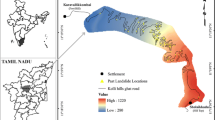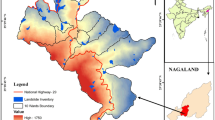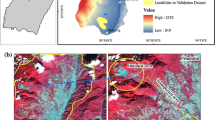Abstract
The present study emphasizes the application of fuzzy operators in landslide susceptibility mapping along Yercaud ghat road section in the state of Tamil Nadu, India. Yercaud is one of the important hill stations and tourist spot in Tamil Nadu. In recent times, it faces frequent landslide occurrences. There is a urgent need for detail study of landslides along the ghat road to prevent further slope failure. The study has been conducted through integrated remote sensing, GIS and field investigations. The existing landslide locations were collected from previous study and verified in the field. The slope gradient, slope aspect, relief, lithology, land cover, geomorphology, proximity to road, proximity to drainage and proximity to lineament were analyzed with the help of Survey of India topo map, published geology map and satellite data. The relationship between various causative factors with past landslide locations were compared using frequency ratio method. These frequency ratio values were normalized to get fuzzy membership values between 0 to 1. The parameter maps with membership values were integrated using fuzzy algebraic product, fuzzy algebraic sum and fuzzy gamma operators to get final landslide susceptibility map. The produced map was verified by comparing with existing landslide locations for calculating prediction accuracy. The fuzzy gamma operator (γ=0.975) showed the highest accuracy of 0.7895.
Access provided by Autonomous University of Puebla. Download conference paper PDF
Similar content being viewed by others
Keywords
1 INTRODUCTION
Landslide is one of the most frequently occurring disasters in hilly regions, which affects human life, property, economy and environment. The occurrence of landslides are influenced by various causative factors and triggered by several external factors, such as intense rainfall, earthquake shaking, water level change, and rapid stream erosion etc., [1]. Anthropogenic activities like building road network, urban development, deforestation, and rapid land use modification, may also influence occurrence of landslides [2]. Landslide susceptibility refers to the probability of occurrence of landslide in an area based on the correlation between causative factors and spatial distribution of landslides [3]. Landslide susceptibility map shows the stable and possible zones for future landslide occurrence [4].
Various landslide hazard assessment techniques were categorized under two broad categories viz., qualitative and quantitative [5]. The quantitative approaches includes statistical [6], probabilistic [7], and distribution free methods such as fuzzy logic [8, 9] and artificial neural network [10] methods. In the present case, landslide susceptibility mapping along ghat road of Yercaud hills were carried out using fuzzy algebraic product (FAP), fuzzy algebraic sum (FAS), and fuzzy gamma operators (FGO). The resultant susceptibility maps were compared with previous landslide locations and prediction accuracy were evaluated.
2 STUDY AREA
Yercaud is one of the important tourist spots in Tamil Nadu and situated on the Shevaroy Hills in Salem district. Pleasant climate prevailing in Yercaud hills throughout the year. The highest altitude of 1437m above mean sea level (amsl) is present near the Longlipettai area. Yercaud ghat section exposes with a less to moderately weathered charnockites under Archean formations. The ghat road is constructed in southwestern slope of Shevaroy hills by cut slopes. The length of the ghat road is 20 km built with 20 hairpin bends. It is located between 11°42’27” N and 11°46’57” N latitudes and 78°10’39” E and 78°12’21” E longitudes (Fig. 82.1). The ghat road section associated with mild soil erosion, intensive rainfall, weathering, and other anthropogenic activities in the form of widening of roads, which leads to slope failure.
3 GEOSPATIAL DATABASE
The landslide incident details were collected from previous [11]. The previous landslide locations were placed along ghat road sections, which were mapped out from IRS P6 LISS IV satellite data. The total numbers of previous landslides are 15. Most of the landslides were occurred in the mid section of ghat road, where hairpin bends are more with high relief condition. The entire section of ghat road is covered by charnockites [12]. The geomorphology and land cover maps were interpreted from IRS-P6 LISS IV satellite image. The ghat road mostly covers structural hill systems and intermontane valley. The topographical factors such as slope, slope aspect, and relief were derived from SRTM DEM data. The relief in the ghat road ranges between 312 and 1437 m amsl and divided into five equal interval classes (Table 82.1). Road buffer of (10m) was prepared using proximity analysis tool in GIS environment. The drainage map was prepared with topographical map on 1:50,000 scale and updated with satellite data. Various buffer zones were created from drainage map to generate proximity to drainage map. Lineaments were interpreted from satellite imagery and different buffer zones were created to do proximity analysis.
4 FUZZY SET THEORY
Fuzzy set theory was first introduced by [13], which is differs from the conventional Boolean set theory in such a manner objects within a set is definite. In fuzzy set, the extent of membership values of an object can have values ranges between 0 to 1, instead of having complete membership 0 or 1 as in a conventional set. The assignment of membership values between 0 and 1 plays a vital role in the fuzzy logic analysis. There is no regulation to assign the fuzzy membership values. The only thing is the selected values must imitate the extent of membership of a set. It can be user-defined based on subjective investigation [14] or the values can be derived from statistical analysis like information value [15] and from frequency ratio [16] or it can be assigned by various functions representing the reality such as J-shaped, Sigmoidal and Linear [17] or by using analytical hierarchical method [18]. With respect to a given data set (a thematic map), a membership can be assigned to each map category according to its direct/indirect relationship with the phenomena in consideration [18]. Five operators were discussed by [14] viz., the fuzzy AND, fuzzy OR, fuzzy algebraic product, fuzzy algebraic sum, and fuzzy gamma operator. This study uses the fuzzy algebraic product, fuzzy algebraic sum, and fuzzy gamma operator for combining the fuzzy membership values.
The fuzzy algebraic sum is defined as:
where μi is the fuzzy membership function for the ‘i’ th map, and i = 1, 2, 3,…, n maps to be combined.
where γ is a value chosen in the range 0 to 1; FAS = Fuzzy Algebraic Sum and FAP = Fuzzy Algebraic Product.
In the present study, the membership values for each thematic layer were derived by normalizing the probability frequency ratio values calculated using Eq. 82.4 (Table 82.1).
where,
However, the zero membership values has been assigned as 0.0001 in order to avoid the complete slackness of a class in a thematic map LHZ analysis [9].
5 RESULTS AND DISCUSSION
For the purpose of integration using fuzzy operator models, all the nine landslide influencing factors were converted to a raster format with 5.8m x 5.8m size grids to calculate the landslide susceptibility index. The total number of grids are 374798, and the total number of landslide grids are 15 in the study area. All the influencing factors were taken to the spatial analysis extension module of the ArcGIS software for integration. The landslide susceptibility index (LSI), were calculated based on the integration rules as shown in Eq. 82.1, Eq. 82.2, and Eq. 82.3. If the LSI value is high, it means a higher susceptibility to landslide; a lower value means a lower susceptibility to landslides. For fuzzy algebraic product, LSI values had a minimum value of 0 and a maximum value of 1, with a standard deviation of 0.0156 and the mean is 0.0007. For fuzzy algebraic sum, LSI values had a minimum value of 1.0208 and a maximum value of 10, with a standard deviation of 1.5809 and the mean is 4.3377. In the case of fuzzy gamma operator, the value of γ was set to 0.1, 0.2, 0.3, 0.4, 0.5, 0.6, 0.7, 0.8, 0.9, 0.975, 0.98, 0.985, and 0.99 to observe its effect on the landslide susceptibility map. The integrated result with the gamma value of γ=0.975 have shown highest accuracy than other values tested in the present study. In the case of applying the gamma operator (γ=0.975) the minimum, mean, maximum, and standard deviation values of LSI are 0.1809, 0.4737, 1, and 0.1492, respectively. The landslide susceptibility map is classified into equal intervals and grouped into five susceptibility classes for visual interpretation viz. very low, low, moderate, high and very high (Fig. 82.1).
Model validation is performed using the known locations of landslides and the landslide susceptibility map. The Area Under Curve (AUC) is one of the most commonly used qualitative accuracy assessment method for the prediction models in natural hazard assessment [19]. The success rate describes how well the model and factor predict the landslide [20]. The accuracy of fuzzy operator models in landslide susceptibility mapping along the Yercaud ghat road section was evaluated by calculating “area under the curve (AUC)”. The AUC value of success rate curve for FAP, FAS, and FGO respectively 0.0356, 0.7178, and 0.7895, where FGO (using γ=0.975) has shown were shown highest accuracy value (Fig. 82.2).
6 CONCLUSIONS
The fuzzy logic approach is one of the easiest and simplest methods to prepare a landslide susceptibility map. In the present study, nine causative factors were combined using fuzzy algebraic product, fuzzy algebraic sum, and fuzzy gamma operator models. The fuzzy gamma operator with a γ value of 0.975 produces the best success rate accuracy of 79%. The landslide susceptibility map produced using fuzzy gamma operator model predicted 60% of the past landslide locations in very high susceptible class, while the high susceptible zone predicted 26.67% of the past landslide locations. The results point out fuzzy gamma operator model shows good prediction pattern than FAP and FAS operators of landslide susceptibility in the study area.
REFERENCES
Ayalew, L., Yamagishi, H. and Ugawa, N.: Landslide susceptibility mapping using GIS based weighted linear combination, the case in Tsugawa area of Agano River, Niigata Prefecture, Japan. Landslides, 1, 73–81 (2004)
Begueria, S.: Validation and evaluation of predictive models in hazard assessment and risk management. Natural Hazards, 37, 315–329 (2006)
Bonham-Carter, G.F.: Geographic information systems for geoscientists: modelling with GIS. Pergamon, Oxford, New York, pp. 292–302 (1994)
Brabb, E.E.: Innovative approaches to landslide hazard and risk mapping. In: Proceedings of 4th International Symposium on Landslides, Toronto, Canada. Volume 1, pp. 307–324. BiTech Publishers, Canada (1984)
Chauhan, S., Sharma, M., Arora, M.K. and Gupta, N.K.: Landslide Susceptibility Zonation through ratings derived from Artificial Neural Network. International Journal of Applied Earth Observations and Geoinformation, 12, 340–350 (2010)
Choi, J., Oh, H.J., Lee, H.J., Lee, C. and Lee, S.: Combining landslide susceptibility maps obtained from frequency ratio, logistic regression, and artificial neural network models using ASTER images and GIS. Engineering Geology, 124, 12–23 (2012)
Chung, C-J.F. and Fabbri, A.G.: Probabilistic prediction models for landslide hazard mapping. Photogrammetric Engineering and Remote Sensing, 65(12), 1389–1399 (1999)
Corominas, J. and Moya, J.: A review of assessing landslide frequency for hazard zoning purposes. Engineering Geology, 102, 193–213 (2008)
Dai, F.C., Lee, C.F. and Ngai, Y.Y.: Landslide risk assessment and management: an overview. Engineering Geology, 64(1), 65–87 (2002)
Das, I., Stein, A., Kerle, N. and Dadhwal, V.K.: Probabilistic landslide hazard assessment using homogeneous susceptible units (HSU) along a national highway corridor in the northern Himalayas, India. Landslides, 8, 293–308 (2011)
GSI: Geological and Mineral Resources map of Tamil Nadu and Pondicherry (1995)
Hearn, G.J.: Landslide and Erosion Hazard Mapping at Ok Tedi Copper Mine, Papua New Guinea. Quarterly Journal of Engineering Geology, 28, 47–60 (1995)
IDRISI: The decision support ring. IDRISI user manual version-4 (1995)
Kanungo, D.P., Arora, M.K., Sarkar, S. and Gupta, R.P.: Landslide Susceptibility Zonation (LSZ) Mapping – A Review. Journal of South Asian Disaster Studies, 2(1), 81–105 (2009)
Kayastha, P., Bijukchhen, S.M., Dhital, M.R. and Smedt, F.D.: GIS Based Landslide Susceptibility Mapping using a Fuzzy Logic Approach: A Case Study from Ghurmi-Dhad Khola Area, Eastern Nepal. Journal Geological Society of India, 82, 249–261 (2013)
Lee, S., Choi, J. and Min, K.: Landslide susceptibility analysis and verification using the Bayesian probability model. Environmental Geology, 43, 120–131 (2002)
Lee, S. and Min, K.D.: Statistical analysis of Landslide Susceptibility at Yongin, Korea. Environmental Geology, 40(9), 1095–1113 (2001)
Lee, S.: Application and verification of fuzzy algebraic operators to landslide susceptibility mapping. Environmental Geology, 52, 615–623 (2007)
McKean, J., Buechel, S. and Gaydos, L.: Remote sensing and landslide hazard assessment. Photogrammetric Engineering and Remote Sensing, 57(9), 1185–1193 (1991)
Saranathan, E., Rajesh Kumar., Kannan, M. and Anbalagan, R.: Landslide Macro Hazard zonation of the Yercaud Hill slopes ghat sections – km 10/4 to 29/6. Indian Landslides, 3(1), 9–16 (2010)
Satty, T.L.: Exploring the interface between hierarchies, multiple objectives and fuzzy set. Fuzzy Sets Syst., 1, 57–68 (1978)
Srivastava, V., Srivastava, H. and Lakhera, R.C.: Fuzzy gamma based geomatic modeling for landslide hazard susceptibility in a part of Tons river valley, northwest Himalaya, India. Geomatics, Natural Hazards and Risk, 1(3), 225–242 (2010)
Van Westen, C.J., Rengers, N. and Soeters, R.: Use of Geomorphological Information in Indirect Landslide Susceptibility Assessment. Natural Hazards. 30, 399–419 (2003)
Wieczorek, G.F.: Preparing a detailed landslide-inventory map for hazard evaluation and reduction. Bulletin Association Engineering Geology, 21, 337–342 (1984)
Yin, K.L. and Yan, T.Z.: Statistical prediction model for slope instability of metamorphosed rocks. In: Proceedings of the 5th International Symposium on Landslides. Lausanne, 2, 1269–1272 (1988)
Zadeh, L.A.: Fuzzy sets. IEEE Information and Control, 8, 125–151 (1965)
Author information
Authors and Affiliations
Corresponding author
Editor information
Editors and Affiliations
Rights and permissions
Copyright information
© 2016 Capital Publishing Company
About this paper
Cite this paper
Ramesh, V., Phaomei, T., Baskar, M., Anbazhagan, S. (2016). Application of Fuzzy Gamma Operator in Landslide Susceptibility Mapping along Yercaud Ghat Road Section, Tamil Nadu, India. In: Raju, N. (eds) Geostatistical and Geospatial Approaches for the Characterization of Natural Resources in the Environment. Springer, Cham. https://doi.org/10.1007/978-3-319-18663-4_82
Download citation
DOI: https://doi.org/10.1007/978-3-319-18663-4_82
Publisher Name: Springer, Cham
Print ISBN: 978-3-319-18662-7
Online ISBN: 978-3-319-18663-4
eBook Packages: Earth and Environmental ScienceEarth and Environmental Science (R0)






